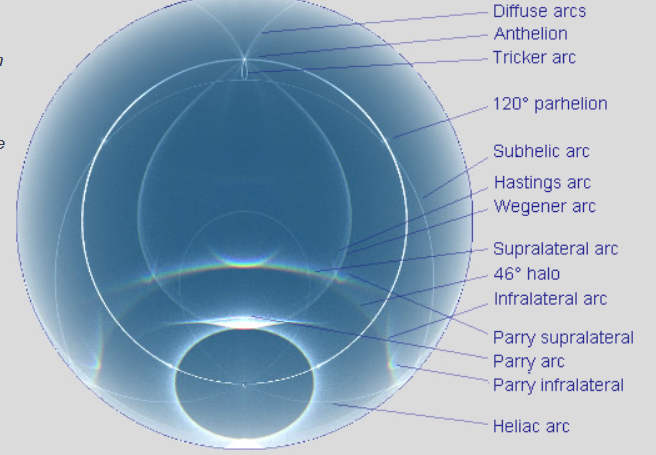Infrequent Arcs
Infrequent Arcs: Rare Gems in the Sky
The sky is a canvas of ever-changing wonders, and among its many marvels are atmospheric optics phenomena. While we may be familiar with common optical events like rainbows and sun halos, there are other, less frequently seen arcs that grace the heavens. These elusive arcs are like rare gems, appearing infrequently and captivating those fortunate enough to witness them.
One such arc is the circumzenithal arc, often referred to as the "smile in the sky." This ethereal display forms when sunlight interacts with ice crystals in cirrus clouds. Unlike rainbows, which are formed by raindrops, circumzenithal arcs are created by hexagonal ice crystals acting as prismatic mirrors. The result is a stunning arc that arcs upward from the horizon, resembling an upside-down rainbow.
Another enchanting but infrequent arc is the supralateral arc. Like its more common cousin, the parhelic circle, the supralateral arc is formed by sunlight passing through ice crystals. However, unlike the parhelic circle, which forms a halo around the sun, the supralateral arc stretches horizontally across the sky. It appears as a faint band of light above the horizon, parallel to the horizon and at the same height as the sun.
The subparhelic circle is yet another captivating phenomenon that belongs to the family of infrequent arcs. This circular arc is formed by sunlight refracting through hexagonal ice crystals. Similar to the supralateral arc, the subparhelic circle is situated parallel to the horizon and at the same altitude as the sun. However, it appears below the horizon and can only be seen when the sun is low in the sky.
Among these rare atmospheric gems is the 46-degree halo. This halo appears as a circle of light around the sun or moon and is caused by light refracting through hexagonal ice crystals. While the 22-degree halo is more commonly observed, the 46-degree halo is a rarer sight. It forms when the ice crystals are aligned in such a way that they create a larger angle of refraction, resulting in a larger halo.
The elusive Wegener arc is yet another infrequent arc that astounds observers lucky enough to spot it. This arc is a faint, white band of light that stretches horizontally across the sky. It forms when sunlight interacts with column-shaped ice crystals in the atmosphere. The Wegener arc is often seen in polar regions and is named after the German geophysicist Alfred Wegener, who first described it.
The Lowitz arc is a rare optical phenomenon that adds an extra touch of magic to the sky. This arc appears as a pair of curved lines extending from either side of the sun or moon. It is caused by light refracting through plate-shaped ice crystals in the atmosphere. The Lowitz arc is named after the German astronomer Carl Ludwig Christian Rümker von Lowitz, who first documented it in the early 19th century.
The upper tangent arc is a captivating but infrequent optical event that occurs above the 22-degree halo. It appears as a short, bright segment of an arc just touching the upper edge of the halo. This phenomenon is caused by sunlight refracting through randomly oriented ice crystals. While the 22-degree halo is a familiar sight, witnessing its upper tangent arc is a rare treat.
The Parry arc is a striking atmospheric phenomenon that adds a touch of mystery to the sky. This arc appears as a bright spot or short segment of an arc on the side of the 22-degree halo. It is caused by sunlight refracting through plate-shaped ice crystals with specific orientations. The Parry arc is named after Sir William Edward Parry, a British Arctic explorer who documented this optical event during his expeditions.
The Wegener-Paetzold effect is a rare atmospheric phenomenon that occurs when sunlight interacts with column-shaped ice crystals. This effect produces a pair of bright spots on either side of the sun, creating a stunning display known as the "sun dog." These bright spots are caused by the refraction and reflection of sunlight within the ice crystals. The Wegener-Paetzold effect is named after Alfred Wegener and the German meteorologist Walter Georgii Paetzold, who extensively studied this phenomenon.
In conclusion, the sky holds a wealth of atmospheric optics phenomena, some of which are rarely seen. From the captivating circumzenithal arc to the mesmerizing Wegener-Paetzold effect, these infrequent arcs are like hidden treasures waiting to be discovered. So keep your eyes on the sky, for you never know when you might catch a glimpse of one of these rare gems illuminating the heavens.
Less frequently seen halos
An all sky HaloSim simulation for a 26° high sun and very well aligned cloud crystals.
Some of these halos might be expected to be visible on average more than once a year. Others are once in a lifetime sights.

Note: this article has been automatically converted from the old site and may not appear as intended. You can find the original article here.
Reference Atmospheric Optics
If you use any of the definitions, information, or data presented on Atmospheric Optics, please copy the link or reference below to properly credit us as the reference source. Thank you!
-
<a href="https://atoptics.co.uk/blog/infrequent-arcs/">Infrequent Arcs</a>
-
"Infrequent Arcs". Atmospheric Optics. Accessed on April 27, 2024. https://atoptics.co.uk/blog/infrequent-arcs/.
-
"Infrequent Arcs". Atmospheric Optics, https://atoptics.co.uk/blog/infrequent-arcs/. Accessed 27 April, 2024
-
Infrequent Arcs. Atmospheric Optics. Retrieved from https://atoptics.co.uk/blog/infrequent-arcs/.